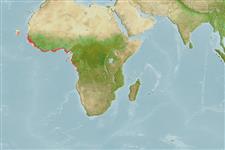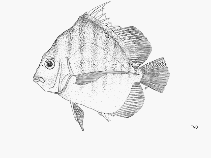Add your observation in Fish Watcher
| Native range | All suitable habitat | Point map | Year 2050 |

|
| This map was computer-generated and has not yet been reviewed. |
| Drepane africana AquaMaps Data sources: GBIF OBIS |
Upload your photos and videos
Pictures | Stamps, coins, misc. | Google imageDrepane africana
Picture by FAO
Pictures | Stamps, coins, misc. | Google imageDrepane africana
Picture by FAO
Common names from other countries
Classification / Names ຊື່ສາມັນ | ຄຳສັບຄ້າຍຄືກັນ | Catalog of Fishes(ຕະກຸນ, ຊະນິດ) | ITIS | CoL | WoRMS | Cloffa
> Acanthuriformes (Surgeonfishes) > Drepaneidae (Sicklefishes)
Etymology: Drepane: Greek, drepane = sickle (Ref. 45335).
Etymology: Drepane: Greek, drepane = sickle (Ref. 45335).
Environment: milieu / climate zone / depth range / distribution range ນິເວດວິທະຍາ
ສັດທະເລ; ນ້ຳກ່ອຍ ກ່ຽວກັບ (ຢູ່)ເທິງຊັ້ນພື້ນດິນໃນທະເລເປີດ; ລະດັບຄວາມເລິກ 10 - 75 m (Ref. 27000), usually 20 - 50 m (Ref. 81287). Tropical; 30°N - 17°S, 27°W - 13°E
ການແຜ່ກະຈາຍ ປະເທດ | ເຂດ FAO | ລະບົບນິເວດ | ການປະກົດຕົວ | Point map | ການແນະນຳ | Faunafri
Eastern Atlantic: West African coast, from Senegal to Angola (Ref. 7350, 81287). Also reported from the Canary Islands, Cape Verde (Ref. 7350) and Mauritania (Ref. 5377).
ຂະໜາດ / ນ້ຳໜັກ / Age
Maturity: Lm ? range ? - ? cm
Max length : 45.0 cm TL ຕົວຜູ້/ບໍ່ມີເພດ; (Ref. 1380); common length : 30.0 cm TL ຕົວຜູ້/ບໍ່ມີເພດ; (Ref. 3609); ນ້ຳໜັກສູງສຸດທີ່ເຄຍຈັດພີມມາ: 750.00 g (Ref. 4883)
Max length : 45.0 cm TL ຕົວຜູ້/ບໍ່ມີເພດ; (Ref. 1380); common length : 30.0 cm TL ຕົວຜູ້/ບໍ່ມີເພດ; (Ref. 3609); ນ້ຳໜັກສູງສຸດທີ່ເຄຍຈັດພີມມາ: 750.00 g (Ref. 4883)
Short description ຕົວທີ່ໃຊ້ໃນການຈຳແນກຊະນິດ | ສະລີລະວິທະຍາ | ການວັດແທກຮູບຮ່າງລັກສະນະພາຍນອກຂອງດິນ,ສັດ,ປາ…
ຄີ (ໜາມ)ແຂງຢູ່ຫຼັງປາ (ທັງໝົດ) : 8 - 9; ຄີຫຼັງຂອງປາ (ຄີອ່ອນ) (ທັງໝົດ) : 17 - 18; ຄີ(ໜາມ) ແຂງຢູ່ຄີກົ້ນປາ
ກຸ່ມປາກະດູກແຂງ
ຄວາມຖີ່ຂອງກຸ່ມຖ່າຍທອດພັນ
ປາທີ່ມີການເຄື່ອນຍ້າຍຈາກທະເລໄປຫານ້ຳຈືດ ແລະນ້ຳຈືດຫາທະເລ
ປາທີ່ມີການເຄື່ອນຍ້າຍຈາກທະເລແລະໄປໄຂ່ຢູ່ນ້ຳຈືດ
ຄີກົ້ນຂອງປາ
ສັດທີ່ມີກະດູກສັນຫັຼງ
ການຖ່າຍທອດທາງກຳມະພັນຈາກພໍ່ແມ່ຫາລູກ: 3; ຄີກົ້ນຂອງປາ: 20 - 21. Diagnosis: body deep and strongly compressed, its anterior profile very steep up to dorsal-fin origin, and strongly compressed; head small; snout short; mouth small, terminal, strongly protrusible, with fleshy lips; teeth slender and pointed, set in bands in upper jaw; roof of mouth toothless; dorsal fin deeply notched; 1st dorsal fin spine small, forward-pointing and visible only in young individuals; pectorals falcate, very long, their tips almost reaching to caudal-fin base; hind margin of caudal fin slightly rounded; pelvic fins thoracic; scales finely ctenoid, covering body, bases of dorsal and anal fins and head, except snout and preopercle; preopercular margin denticulate; lateral line strongly arched (Ref. 81287).
Coloration: silvery grey, darker on back, almost white on belly; sides with a series of 8 brown, more or less faded vertical bars, always more distinct in young individuals (Ref. 81287).
Neritic species (Ref. 7350). Essentially marine, often living in groups (Ref. 81287) over sandy and muddy bottoms (Ref. 2683), between 20 and 50 m depth, and entering coastal lagoons where sexual maturation begins (Ref. 81287). Feeds of fish eggs, benthic invertebrates and detritus (Ref. 28587).
Life cycle and mating behavior ການຈະເລີນເຕັມໄວ | ການສືບພັນ | ການວາງໄຂ່ | ໄຂ່ | ຄວາມດົກຂອງໄຂ່ປາ | ຕົວອ່ອນ
Main reference
Upload your references | ເອກະສານອ້າງອີງ | ຜູ້ປະສານງານ | ຜູ້ຮ່ວມມື
Desoutter, M., 1990. Ephippidae. p. 834-836. In J.C. Quero, J.C. Hureau, C. Karrer, A. Post and L. Saldanha (eds.) Check-list of the fishes of the eastern tropical Atlantic (CLOFETA). JNICT, Lisbon; SEI, Paris; and UNESCO, Paris. Vol. 2. (Ref. 7350)
Threat to humans
Harmless
Human uses
ການປະມົງ: ທີ່ເປັນການຄ້າໜ້ອຍ
FAO(ການປະມົງ: ຜົນຜະລິດ; publication : search) | FishSource |
ຂໍ້ມູນຕື່ມອີກ
Population dynamics
ຕົວວັດແທກການເຕີບໃຫຍ່
Max. ages / sizes
Length-weight rel.
Length-length rel.
Length-frequencies
Mass conversion
ການທົດແທນທີ່
ຄວາມອຸດົມສົມບູນ
ຕົວວັດແທກການເຕີບໃຫຍ່
Max. ages / sizes
Length-weight rel.
Length-length rel.
Length-frequencies
Mass conversion
ການທົດແທນທີ່
ຄວາມອຸດົມສົມບູນ
Life cycle
ການສືບພັນ
ການຈະເລີນເຕັມໄວ
ຄວາມດົກຂອງໄຂ່ປາ
ການວາງໄຂ່
Spawning aggregations
ໄຂ່
Egg development
ຕົວອ່ອນ
ການປ່ຽນແປງຂອງຕົວອ່ອນ
ການສືບພັນ
ການຈະເລີນເຕັມໄວ
ຄວາມດົກຂອງໄຂ່ປາ
ການວາງໄຂ່
Spawning aggregations
ໄຂ່
Egg development
ຕົວອ່ອນ
ການປ່ຽນແປງຂອງຕົວອ່ອນ
Anatomy
ເນື້ອທີ່ເຫືອກ
Brain
Otolith
ເນື້ອທີ່ເຫືອກ
Brain
Otolith
Physiology
Body composition
Nutrients
ການບໍລິໂພກອົກຊີເຈນ
ປະເພດການລອຍ
ຄວາມໄວໃນການລອຍ
Visual pigments
Fish sound
Diseases & Parasites
Toxicity (LC50s)
Body composition
Nutrients
ການບໍລິໂພກອົກຊີເຈນ
ປະເພດການລອຍ
ຄວາມໄວໃນການລອຍ
Visual pigments
Fish sound
Diseases & Parasites
Toxicity (LC50s)
Genetics
ກຳມະພັນ
Heterozygosity
ການຖ່າຍທອດທາງກຳມະພັນຈາກພໍ່ແມ່ຫາລູກ
ກຳມະພັນ
Heterozygosity
ການຖ່າຍທອດທາງກຳມະພັນຈາກພໍ່ແມ່ຫາລູກ
ເຄື່ອງມື
E-book | ຄູ່ມືພາກສະໜາມ | ຄວາມຖີ່ຂອງຄວາມຍາວປາ | ເຄື່ອງມືຂອງຊີວະປະຫວັດທາງດ້ານຊີວິດ | ຈຸດໃດໜຶ່ງທີ່ສະແດງອອກໃນແຜນທີ່ (ພ້ອມທັງສະແດງຂໍ້ມູນເພີ້ນເຕີມ) | Classification Tree
| Catch-MSY |
Special reports
Download XML
ແຫຼ່ງອີນເຕີເນັດ
Aquatic Commons | BHL | Cloffa | Websites from users | Check FishWatcher | CISTI | Catalog of Fishes(ຕະກຸນ, ຊະນິດ) | DiscoverLife | ECOTOX | Faunafri | Fishtrace | GenBank(genome, nucleotide) | GloBI | GOBASE | | Google Books | Google Scholar | Google | IGFA World Record | MitoFish | Otolith Atlas of Taiwan Fishes | PubMed | Reef Life Survey | Scirus | SeaLifeBase | ແຜນທີ່ສະແດງກິ່ງງ່າຂອງເຊື້ອຕະກຸນປາ, ສັດ ຈາກບັນພະບູລຸດຈົນເຖິງຫລານ | Wikipedia(Go, ຊອກຫາ) | World Records Freshwater Fishing | ການບັນທຶກດ້ານສັດວິທະຍາ
Estimates based on models
Preferred temperature (Ref. 115969): 19.2 - 28, mean 26.1 (based on 132 cells).
Phylogenetic diversity index (Ref. 82804): PD50 = 0.7500 [Uniqueness, from 0.5 = low to 2.0 = high].
Bayesian length-weight: a=0.01380 (0.00724 - 0.02632), b=2.98 (2.81 - 3.15), in cm Total Length, based on LWR estimates for this species & (Sub)family-body (Ref. 93245).
ຊັ້ນເຂດຮ້ອນ (Ref. 69278): 3.1 ±0.41 se; based on food items.
ຄວາມຢືດຢຸ່ນ (Ref. 120179): ຂະໜາດກາງ, ປະຊາກອນຕຳ່ສຸດທີ່ໃຊ້ເວລາສອງເທົ່າ 1.4 - 4.4 ປີ (K=0.13-0.25).
Fishing Vulnerability (Ref. 59153): High vulnerability (56 of 100).




